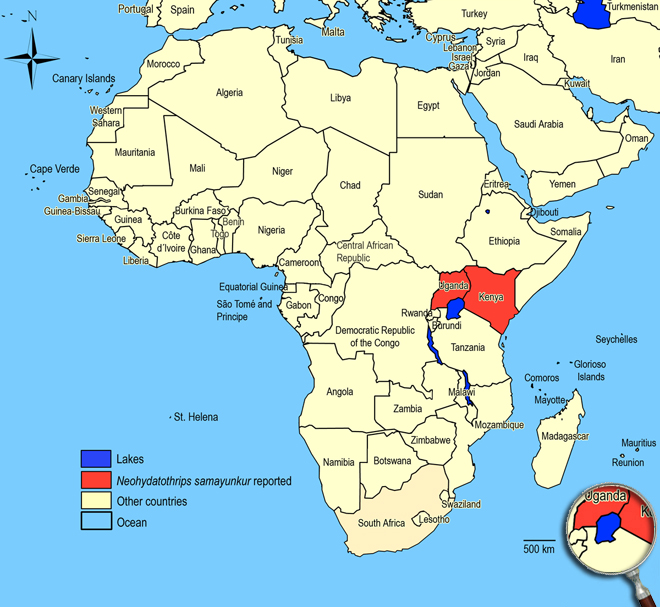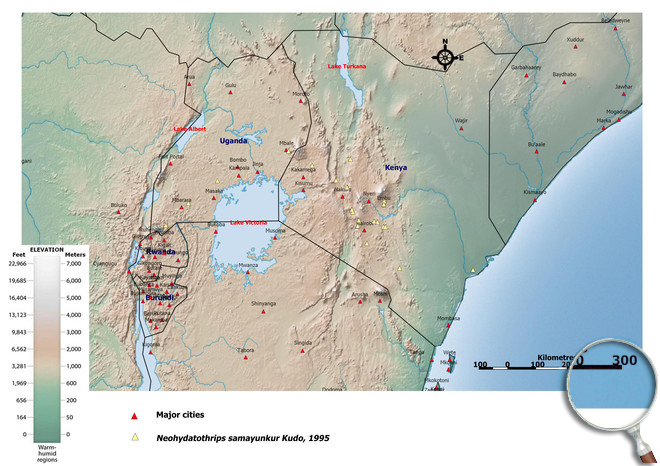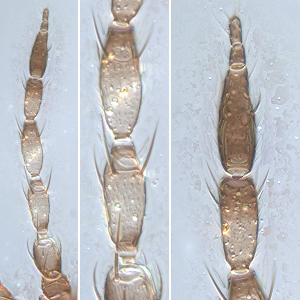Neohydatothrips samayunkur Kudo, 1995
Sericothripinae, Thripidae, Terebrantia, Thysanoptera
Figures
Fig. 1: 8-segmented antenna, segments III and IV with forked sense cone, terminal segments V-VIII
Fig. 2: Head dorsal with ocellar triangle
Fig. 3: Pronotum
Fig. 4: Meso- and metanotum
Fig. 5: Furca of meso- and metasternum
Fig. 6: Meso- and metasternum
Fig. 7: Fore- and hind wing, fore wing distal region
Fig. 8: Tergites II and III
Fig. 9: Tergites VII and VIII
Fig. 10: Sternites VIII and IX (male)
Introduction and recognition
Neohydatothrips samayunkurbreeds in the flowers and the leaves of Tagetes species. Both sexes fully winged; body strikingly bicolored, mainly dark brown with abdominal segments 3-6 yellowish with brown antecostal ridge; anterior margin of pronotum yellow, also all tarsi, base and apex of tibiae, and much of antennal segments II-V; fore wings pale with small brown area at base and two transverse brown bands, apex pale. Antennae 8-segmented; segments III and IV with sense cone forked and relatively short, VI with base of sense cone elongate and about half as long as this segment (Fig. 1). Head wider than long, with occipital ridge not close to eyes; postocular region short; ocellar triangle with irregular lines of sculpture; 3 pairs of curved ocellar setae, pair III on anterior margins of triangle; 3 pairs of postocular setae (Fig. 2). Pronotum with transversely elongate reticles on anterior half, the darker pronotal blotch with more closely spaced transverse striae and deeply emarginate posteriorly on posterior half; 1 pair of long posteroangular setae (Fig. 3). Metanotum median area with sculptured lines, transverse at anterior but longitudinal and parallel on posterior half; median setae at anterior margin, campaniform sensilla absent; metasternum with anterior margin almost transverse (Fig. 4). Meso- and metafurca with stout median spinula (Fig. 5 and 6). Mid- and hind tarsi 2-segmented, Fore wing first vein distinct from costal vein and with continuous row of setae; second vein without setae (Fig. 7). Lateral thirds of tergites I-VIII with many rows of fine and regular microtrichia (Fig. 8); I-VI with posteromarginal comb of microtrichia present laterally, incomplete medially; tergites VII and VIII with complete comb of long and regular microtrichia; tergites I-VIII with median pair of setae not similarly placed, nor of similar size on all tergite; median setal pairs longer than distance between their bases (Fig. 9), sternites without discal setae but fully covered with rows of microtrichia; posterior margins with comb of long microtrichia between the marginal setae. Sternite VII median posteromarginal setae S1 arising in front of margin.
Male similar to female but smaller and more slender; tergite IX discal setae long; sternite VII with weak glandular area.
Second instar larva white with grey shading on tibiae, antennae and laterally on thorax, also distal half of tergite X; with much red internal pigment; tergal major setae with fimbriate, broadly expanded and asymmetric, apices, the median pair on IX close together; spiracles on VIII surrounded by extensive sculptured area (Fig. 10).
Taxonomic identity
Species
Neohydatothrips samayunkur Kudo, 1995
Taxonomic history
Hydatothrips (Neohydatothrips) samayunkur Kudo, 1995
Common name
Marigold thrips
Present taxonomic position
Family: Thripidae Stephens, 1829
Subfamily: Sericothripinae Karny, 1921
Genus: Neohydatothrips John, 1929
Genus description
The genus Neohydatothrips
The genus Neohydatothrips is widespread around the world in tropical and subtropical countries and is currently used for a group of 100 species, several have bodies that are prominently bicolored as well as banded wings while others are uniformly pale or yellow. Neohydatothrips is a member of the subfamily Sericothripinae, closely related to Hydatothrips and Sericothrips. These thrips all have numerous closely spaced rows of microtrichia on the lateral thirds of the tergites, fore wings with a complete row of setae on the first vein whereas second vein without or only with 2 setae. Most of them have a remarkably elongate base to the sense cone on the sixth antennal segment, and a distinctive colored and/or sculptured area on the pronotum, the pronotal blotch. Bhatti (1973) has given identification keys to distinguish the various genera involved. All species of Neohydatothrips have the metasternum with a transverse line behind anterior margin, this line medially with a T-shaped or Y-shaped apodeme.
Species description
Typical key character states of Neohydatothrips samayunkur
Coloration and body sculpture
Body color: distinctively bicolored
Surface of head, pronotum and fore legs: without obvious or with weakly reticulate sculpture
Antennae
Form of sense cones on antennal segments III and IV: emergent and forked on segments III and IV
Number of antennal segments: 8
Head
Distance between bases of ocellar setae III: greater than width of first ocellus
Ocellar setae I: present
Ocellar setae III: arising on anterior margin of, or in front of ocellar triangle
Ocelli: present
Prothorax
Pronotal blotch or internal apodeme: present
Pronotum shape: broadly rectangular
Pronotum surface: anterior with closely reticulate and/or posterior with more striate sculpture or mainly with transverse striate sculpture
Pronotal blotch: dark and deeply emarginate posteriorly
Mesothorax
Mesothorax: Mesosternal furca: with median spinula
Metathorax
Metanotum with dominant sculptured triangle medially: absent
Metasternal furca: with spinula
Metasternum anterior margin: almost transverse
Sculpture of metanotum median area: transverse at anterior, but longitudinal and parallel on posterior half
Shape of metathoracic furca: transverse, V-shaped
Metascutellum: without microtrichia
Wings
Fore and hind wings: present, more than half as long as abdomen (macropterous)
Fringe cilia arising: from sockets
Fore wing veins: present
Fore- and hind wing surface: covered with microtrichia
Apex of fore wing: with prominent terminal setae
Fore wing costal fringe cilia: arising at anterior margin of wing
Fore wing first vein: distinct from costal vein
Fore wing first vein setal row: complete, with setae closely and uniformly spaced
Fore wing second vein setal row: with no setae
Fore wing shape: mainly parallel sided or margins run continuously towards each other
Fore wing surface: not reticulate
Shape of fore wing apex: with mainly posterior margin curved to join anterior margin
Fore wings: alternating bands of dark and light
Legs
Mid and hind tarsi: with two segments
Abdomen
Sternites V and VI microtrichia: extending fully across discal area
Sternite VII median posteromarginal setae S1: arising in front of posterior margin
Surface of lateral thirds of abdominal tergites: with many regular rows of fine microtrichia
Microtrichia on tergites II to VII: only on lateral thirds, median area smooth or with sparse microtrichia
Median setal pairs on tergites II to VII: dissimilar in size and position
Tergites IV and V median setal pair: longer than distance between their bases
Markings on tergites IV to VI: with shaded areas medially
Tergite VIII ctenidia: without paired ctenidia laterally, sometimes with irregular microtrichia
Tergite VIII posteromarginal comb of microtrichia: present and complete medially
Tergite VIII shape of posteromarginal microtrichia: long, slender and regular on broadly triangular bases
Tergite X: not tubular, longitudinally incomplete

Similar or related species
Neohydatothrips samayunkur is closely related to Hydatothrips adolfifriderici and Sericothrips sativus. Compared to these both species, Neohydatothrips samayunkur has a dark pronotal blotch which is deeply emarginate posteriorly, and metanotal median area sculptured lines are transverse at anterior, but longitudinal and parallel on posterior half. Neohydatothrips samayunkur as well as Sericothrips sativus have the metasternum anterior margin almost transverse. In Hydatothrips adolfifriderici the metasternum has an anterior margin deeply U-shaped and median V-shaped apodeme, the dark pronotal blotch is not emarginate posteriorly, and metanotal median area sculptured lines are also transverse at anterior, but forming irregular longitudinal reticulations on posterior half. In Sericothrips sativus the pronotal blotch is pale, and the metanotal median area sculptured lines are transverse striate. Neohydatothrips samayunkur as well as Hydatothrips adolfifriderici have no microtrichia on metascutellum, dense microtrichia only on lateral thirds on tergites I-VIII and median area smooth or with sparse microtrichia, tergites I-VI posteromarginal comb of microtrichia is present laterally but incomplete medially, median setae are short on tergites I-IV and longer on V-VIII, and the median setal pair is longer than distance between their bases. Whereas Sericothrips sativus has a metascutellum covered with bands of microtrichia medially, also tergites I-VIII completely covered with microtrichia, complete posteromarginal comb of microtrichia on tergites I-VI, the tergal median setae are similarly placed and of equal size, and the median setal pair is shorter than distance between their bases.
Biology
Life history
As with other thrips species the life cycle from egg to adult is dependent on temperature. The full cycle can take about 15 days (Lewis 1973) to over a month and adults may live for more than one month producing several generations in one year depending on seasonal weather. With greenhouse temperatures the developmental time from egg to adult can decrease to about one week.
Host plants
Mainly on Tagetes spp. (Asteraceae).
Crops: amaranth, garlic, kale, potato, pyrethrum, spinach, sweet potato, tomato.
Weeds: Acacia sp., Asystesia mysoorensis, Bidens pilosa, Galinsoga parviflora, Nycandra physalodes, Occimum gratissimum ssp. gratissimum, Rotheca myricoides (butterfly bush), Sida acuata,Solanum incanum, Sonchus oleracea, Tagetes spp., Veronica sp.
Vector capacity
None identified, but possible mechanical distribution of phytopathogenic fungi and bacteria.
Damage and symptoms
Attacked plants showed leaves with scarring, silvering and distortion. Flowers showed no symptoms. In the field, the presence of the pest is indicated by the distortion and purple patches on leaves. Neohydatothrips samayunkur limit the growth of marigold seedlings and also adult plant development (Monteiro et al. 1999).
Detection and control strategies
-
Additional notes
-
Biogeography
Africa, Asia, Australia, New Zealand, Central and South America, North America. Kenya, Uganda.
African countries where Neohydatothrips samayunkur has been reported

Occurence of Neohydatothrips samayunkur in East Africa

Please click here for survey sites of all observed thrips species of Kenya, Tanzania and Uganda.
Click here for locations of Neohydatothrips samayunkur in parts of East Africa.

Bibliography
Bhatti JS (1973). A preliminary revision of Sericothrips Haliday, sensu lat., and related genera, with a revised concept of the tribe Sericothripini (Thysanoptera: Thripidae). Oriental Insects. 7 (3): 403-449
Kudo I (1995). A new species of Hydatothrips (Thysanoptera: Terebrantia: Thripidae) on marigold in Japan and the United States. Applied Entomology and Zoology. 30 (1): 169-176
Lewis T (1973). Thrips: their biology, ecology and economic importance. Academic Press Inc., London Ltd., 349 pp
Monteiro RC, Zawadnea MAC & Mound LA (1999). Neohydatothrips samayunkur (Kudô) (Thysanoptera: Thripidae) infesting marigold (Tagetes patula, Compositae) in Brazil. Anais da Sociedade Entomológica do Brasil. 28 (2): 323-326
Moritz G (2006). Thripse. Pflanzensaftsaugende Insekten, Bd. 1, (1. Auflage). Westarp, Hohenwarsleben, 384 pp. ISBN-13: 978 3 89432 891 7
Moritz G, Morris DC & Mound LA (2001). ThripsID - Pest thrips of the world. ACIAR and CSIRO Publishing Collingwood, Victoria, Australia, CDROM ISBN 1 86320 296 X
Moritz G, Mound LA, Morris DC & Goldarazena A (2004). Pest thrips of the world - an identification and information system using molecular and microscopical methods. Centre for Biological Information Technology, University of Queensland, Australia, CDROM ISBN 1 86499 781 8
Moritz G, O'Donnell C & Parrella M (2009). Pest thrips of North America. Centre for Biological Information Technology, University of Queensland, Australia, CDROM ISBN-13: 978 1 86499 940 2
Mound LA, Goodwin S & Steiner MY (1996). Neohydatothrips pseudoannulipes Johansen (Thysanoptera: Thripidae), a pest thrips on African marigolds new to Australia, with one new synonym. Australian Journal of Entomology. 35: 201-202
Mound LA & Kibby G (1998). Thysanoptera: An identification guide, (2nd edition). CAB International, Wallingford and New York, 70 pp
Mound LA & Marullo R (1996). The thrips of Central and South America: An introduction (Insecta: Thysanoptera). Memoirs on Entomology, International, Vol. 6. Associated Publishers, Gainesville, 487 pp.
Mound LA & Tree DJ (2009). Identification and host-plant associations of Australian Sericothripinae (Thysanoptera, Thripidae). Zootaxa. 1983: 1-22
Nakahara S (1999). Validation of Neohydatothrips samayunkur (Kudo) (Thysanoptera: Thripidae) for a thrips damaging marigolds (Tagetes spp.). Proceedings of the Entomological Society of Washington. 101 (2): 458-459
Nickle DA (2003). A checklist of commonly intercepted thrips (Thysanoptera) from Europe, the Mediterranean, and Africa at U.S. ports-of-entry (1983-1999). Part I. Key to genera. Proceedings of the Entomological Society of Washington. 105 (1): 80-99
OEPP/EPPO (2005). EPPO report on notifications of non-compliance (detection of regulated pests). EPPO Reporting Service 2005, No. 2, pp. 10-18
Wang C-L (2007). Hydatothrips and Neohydatothrips (Thysanoptera, Thripidae) of East and South Asia with three new species from Taiwan. Zootaxa. 1575: 47-68
----
Web links
Mound´s Thysanoptera pages
Thysanoptera Checklist
ICIPE Thrips survey sites
UNI Halle & Thrips sites
Thrips of California














